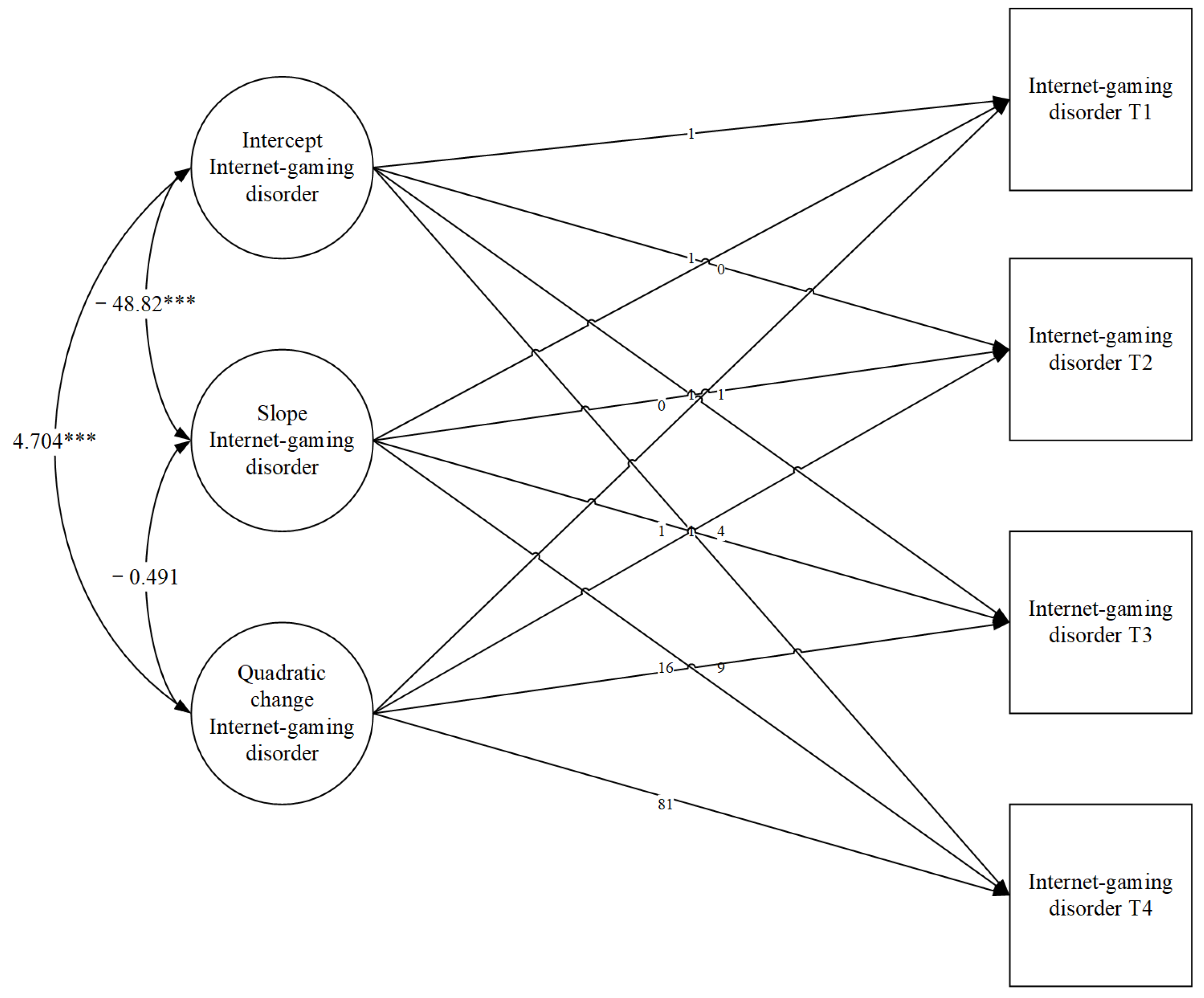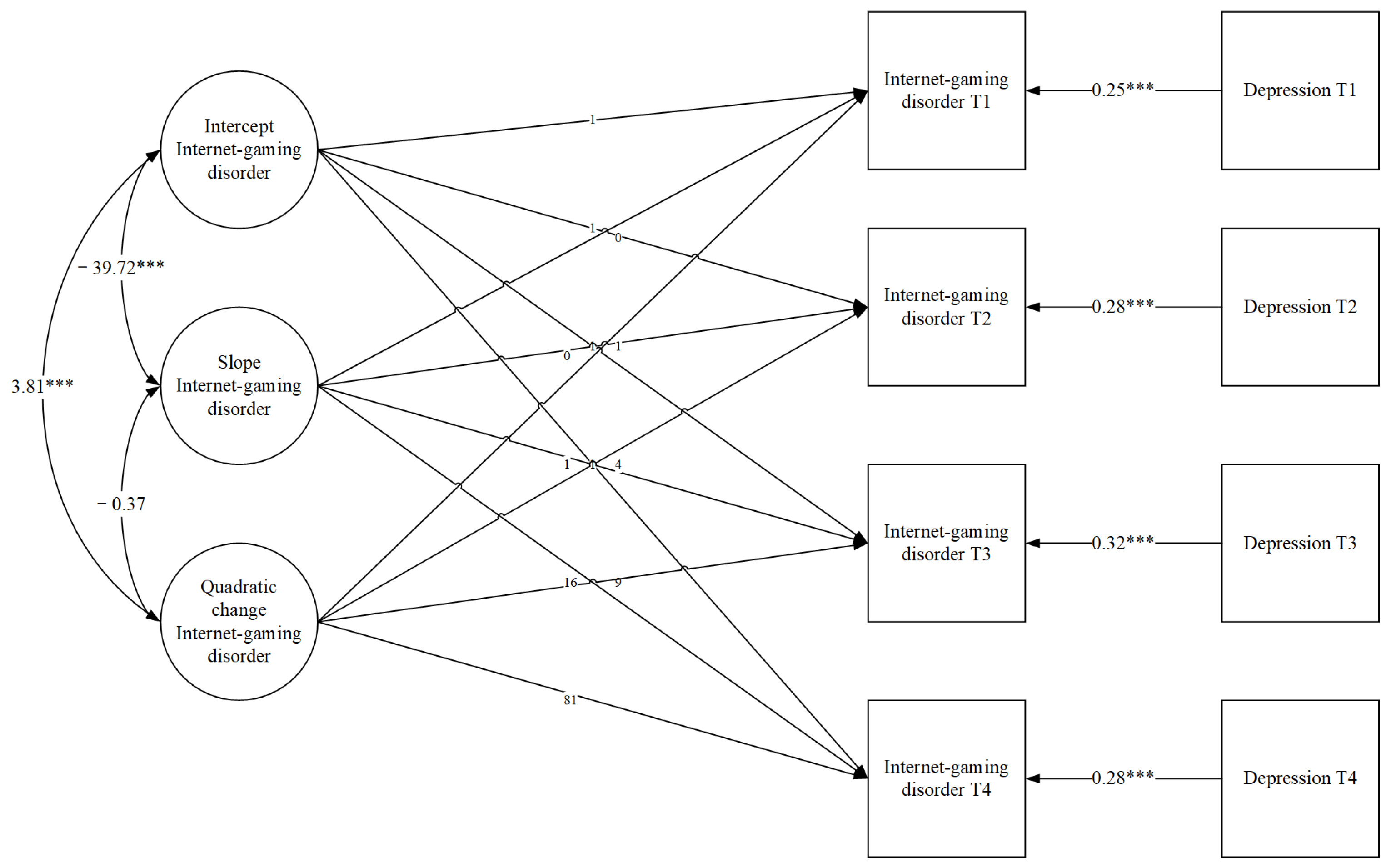Internet Gaming Disorder in Early Adolescents: Gender and Depression Differences in a Latent Growth Model
Abstract
:1. Introduction
2. Materials and Methods
2.1. Participants
2.2. Measures
2.2.1. Internet Gaming Disorder
2.2.2. Depression
2.3. Data Analysis
2.4. Missing Data Analyses
3. Results
3.1. Preliminary Analysis
3.2. Trajectories of Internet Gaming Disorder in Early Adolescence
3.3. Relationship between Gender and Adolescents’ Developmental Trajectories
3.4. Time-Specific Effect of Depression Status on Adolescence’s Internet Gaming Disorder
3.5. Trajectories of Depression and Internet Gaming Disorder in Early Adolescence
4. Discussion
4.1. The Trajectory of Internet Gaming Disorder in Early Adolescents
4.2. Gender Prediction of Internet Gaming Disorders
4.3. Depression Predicts Internet Gaming Disorder
4.4. Research Significance
4.5. Limitations and Prospects
5. Conclusions
Author Contributions
Funding
Institutional Review Board Statement
Informed Consent Statement
Data Availability Statement
Conflicts of Interest
References
- Wong, H.Y.; Mo, H.Y.; Potenza, M.N.; Chan, M.N.M.; Lau, W.M.; Chui, T.K.; Pakpour, A.H.; Lin, C.Y. Relationships between severity of internet gaming disorder, severity of problematic social media use, sleep quality and psychological distress. Int. J. Environ. Res. Public. Health 2020, 17, 1879. [Google Scholar] [CrossRef] [Green Version]
- China Internet Network Information Center. The 47th China Statistical Report on Internet Development; Network Information Center: Beijing, China, 2021. [Google Scholar]
- Chen, I.; Strong, C.; Lin, Y.; Tsai, M.; Lin, C.; Pakpour, A.H.; Griffiths, M.D. Time invariance of three ultra-brief internet-related instruments: Smartphone Application-Based Addiction Scale (SABAS), Bergen Social Media Addiction Scale (BSMAS), and the nine-item Internet Gaming Disorder Scale-Short Form (IGDS-SF9) (Study Part B). Addict. Behav. 2019, 101, 105960. [Google Scholar] [CrossRef] [PubMed] [Green Version]
- Brand, M.; Young, K.S.; Laier, C.; Wölfling, K.; Potenza, M.N. Integrating psychological and neurobiological considerations regarding the development and maintenance of specific Internet-use disorders: An Interaction of Person-Affect-Cognition-Execution (I-PACE) model. Neurosci. Biobehav. Rev. 2016, 71, 252–266. [Google Scholar] [CrossRef] [Green Version]
- Przybylski, A.K.; Weinstein, N.; Murayama, K. Internet gaming disorder: Investigating the clinical relevance of a new phenomenon. Am. J. Psychiatry 2017, 174, 230–235. [Google Scholar] [CrossRef] [PubMed] [Green Version]
- Tao, R.; Huang, X.; Wang, J.; Zhang, H.; Zhang, Y.; Li, M. Proposed diagnostic criteria for internet addiction. Addiction 2010, 105, 556–564. [Google Scholar] [CrossRef]
- Shi, L.; Wang, Y.; Yu, H.; Wilson, A.; Cook, S.; Duan, Z.; Peng, K.; Hu, Z.; Ou, J.; Duan, S.; et al. The relationship between childhood trauma and Internet gaming disorder among college students: A structural equation model. J. Behav. Addict. 2020, 9, 175–180. [Google Scholar] [CrossRef] [PubMed] [Green Version]
- Müller, K.W.; Janikian, M.; Dreier, M.; Wölfling, K.; Beutel, M.E.; Tzavara, C.; Richardson, C.; Tsitsika, A. Regular gaming behavior and internet gaming disorder in European adolescents: Results from a cross-national representative survey of prevalence, predictors, and psychopathological correlates. Eur. Child Adolesc. Psychiatry 2015, 24, 565–574. [Google Scholar] [CrossRef]
- Yen, J.Y.; Lin, H.C.; Chou, W.P.; Liu, T.L.; Ko, C.H. Associations among resilience, stress, depression, and internet gaming disorder in young adults. Int. J. Environ. Res. Public. Health 2019, 16, 3181. [Google Scholar] [CrossRef] [Green Version]
- Yu, H.; Cho, J. Prevalence of Internet Gaming Disorder. Am. J. Health Behav. 2016, 40, 705–716. [Google Scholar] [CrossRef]
- Pontes, H.M.; Macur, M.; Griffiths, M.D. Internet gaming disorder among slovenian primary schoolchildren: Findings from a nationally representative sample of adolescents. J. Behav. Addict. 2016, 5, 304–310. [Google Scholar] [CrossRef] [Green Version]
- Lemmens, J.S.; Valkenburg, P.M.; Gentile, D.A. The internet gaming disorder scale. Psychol. Assess. 2015, 27, 567–582. [Google Scholar] [CrossRef]
- Wichstrøm, L.; Stenseng, F.; Belsky, J.; von Soest, T.; Hygen, B.W. Symptoms of Internet Gaming Disorder in Youth: Predictors and Comorbidity. J. Abnorm. Child Psychol. 2019, 47, 71–83. [Google Scholar] [CrossRef] [PubMed] [Green Version]
- Wartberg, L.; Kriston, L.; Thomasius, R. Internet gaming disorder and problematic social media use in a representative sample of German adolescents: Prevalence estimates, comorbid depressive symptoms and related psychosocial aspects. Comput. Hum. Behav. 2020, 103, 31–36. [Google Scholar] [CrossRef]
- O’Farrell, D.L.; Baynes, K.L.; Pontes, H.M.; Griffiths, M.D.; Stavropoulos, V. Depression and Disordered Gaming: Does Culture Matter? Int. J. Ment. Health Addict. 2020. [Google Scholar] [CrossRef] [Green Version]
- Wang, H.R.; Cho, H.; Kim, D.J. Prevalence and correlates of comorbid depression in a nonclinical online sample with DSM-5 internet gaming disorder. J. Affect. Disord. 2018, 226, 1–5. [Google Scholar] [CrossRef]
- Choi, J.; Cho, H.; Kim, J.Y.; Jung, D.J.; Ahn, K.J.; Kang, H.B.; Choi, J.S.; Chun, J.W.; Kim, D.J. Structural alterations in the prefrontal cortex mediate the relationship between Internet gaming disorder and depressed mood. Sci. Rep. 2017, 7, 1245. [Google Scholar] [CrossRef] [Green Version]
- Yuan, G.; Elhai, J.D.; Hall, B.J. The influence of depressive symptoms and fear of missing out on severity of problematic smartphone use and Internet gaming disorder among Chinese young adults: A three-wave mediation model. Addict. Behav. 2021, 112, 106648. [Google Scholar] [CrossRef]
- Männikkö, N.; Ruotsalainen, H.; Miettunen, J.; Pontes, H.M.; Kääriäinen, M. Problematic gaming behaviour and health-related outcomes: A systematic review and meta-analysis. J. Health Psychol. 2020, 25, 67–81. [Google Scholar] [CrossRef] [Green Version]
- Lin, P.C.; Yen, J.Y.; Lin, H.C.; Chou, W.P.; Liu, T.L.; Ko, C.H. Coping, resilience and perceived stress in individuals with internet gaming disorder in Taiwan. Int. J. Environ. Res. Public. Health 2021, 18, 1771. [Google Scholar] [CrossRef]
- Burleigh, T.L.; Stavropoulos, V.; Liew, L.W.L.; Adams, B.L.M.; Griffiths, M.D. Depression, Internet Gaming Disorder, and the Moderating Effect of the Gamer-Avatar Relationship: An Exploratory Longitudinal Study. Int. J. Ment. Health Addict. 2018, 16, 102–124. [Google Scholar] [CrossRef] [Green Version]
- Wartberg, L.; Kriston, L.; Zieglmeier, M.; Lincoln, T.; Kammerl, R. A longitudinal study on psychosocial causes and consequences of Internet gaming disorder in adolescence. Psychol. Med. 2019, 49, 287–294. [Google Scholar] [CrossRef] [PubMed]
- Van der Graaff, J.; Branje, S.; De Wied, M.; Hawk, S.; Van Lier, P.; Meeus, W. Perspective taking and empathic concern in adolescence: Gender differences in developmental changes. Dev. Psychol. 2014, 50, 881–888. [Google Scholar] [CrossRef] [PubMed] [Green Version]
- Samples, N.; Diagnoses, M.; Salk, R.H.; Hyde, J.S.; Abramson, L.Y.; Hyde, J.S.; Abramson, L.Y. Gender Differences in Depression in Representative National Samples: Meta-Analyses of Diagnoses and Symptoms. Psychol. Bull. 2017, 143, 783–822. [Google Scholar]
- Tsai, M.J.; Tsai, C.C. Junior high school students’ Internet usage and self-efficacy: A re-examination of the gender gap. Comput. Educ. 2010, 54, 1182–1192. [Google Scholar] [CrossRef]
- Bonnaire, C.; Baptista, D. Internet gaming disorder in male and female young adults: The role of alexithymia, depression, anxiety and gaming type. Psychiatry Res. 2019, 272, 521–530. [Google Scholar] [CrossRef]
- Mihara, S.; Higuchi, S. Cross-sectional and longitudinal epidemiological studies of Internet gaming disorder: A systematic review of the literature. Psychiatry Clin. Neurosci. 2017, 71, 425–444. [Google Scholar] [CrossRef] [Green Version]
- Curran, P.J.; Obeidat, K.; Losardo, D. Twelve frequently asked questions about growth curve modeling. J. Cogn. Dev. 2010, 11, 121–136. [Google Scholar] [CrossRef] [Green Version]
- Bollen, K. On the Origins of Latent Curve Models; MacCallum, R., Ed.; Lawrence Erlbaum Associates: Mahwah, NJ, USA, 2007. [Google Scholar]
- Zhang, X. The Development of Social Competence during Early Childhood: A Latent Growth Model. Acta Psychologica Sinica 2011, 43, 1388–1397. [Google Scholar] [CrossRef]
- Király, O.; Sleczka, P.; Pontes, H.M.; Urbán, R.; Grif, M.D.; Demetrovics, Z. Validation of the Ten-Item Internet Gaming Disorder Test (IGDT-10) and evaluation of the nine DSM-5 Internet Gaming Disorder criteria. Addict. Behav. 2015. [Google Scholar] [CrossRef] [Green Version]
- Yu, L.; Yong, W.; Jin, Y.; Jing, X.; Shu, Y. Factorial Structure of the CES-D Scale Among Chinese High School Students. Chin. J. Clin. Psychol. 2008, 16, 265–268. [Google Scholar] [CrossRef]
- Allison, P.D. Missing Data; Sage university papers. Quantitative applications in the social sciences; Sage Publications: Thousand Oaks, Calif, 2002. [Google Scholar]
- Zhang, S.; Chen, N.; Liu, H. LGM-based analyses with missing data: Comparison between ML method and Diggle-Kenward selection model. Acta Psychol. Sin. 2017, 49, 699. [Google Scholar] [CrossRef]
- Muthén, L.K.; Muthén, B.Q. Mplus User’s Guide, 7th ed.; Muthén & Muthén: Los Angeles, CA, USA, 2012; ISBN 9780982998328. [Google Scholar]
- Mengcheng, W.; Xiaowen, D. The mechanism of auxiliary variables in full information maximum likelihood–based structural equation models with missing data. Acta Psychol. Sin. 2016, 48, 1489. [Google Scholar] [CrossRef]
- Wang, J.C.; Wang, X.Q.; Jiang, B.F. Structural Equation Models: Methods and Applications; Higher Education Press: Beijing, China, 2011. [Google Scholar]
- Phan, O.; Prieur, C.; Bonnaire, C.; Obradovic, I. Internet gaming disorder: Exploring its impact on satisfaction in life in PELLEAS adolescent sample. Int. J. Environ. Res. Public. Health 2020, 17, 3. [Google Scholar] [CrossRef] [Green Version]
- Kuss, D.J.; Griffiths, M.D.; Pontes, H.M. Chaos and confusion in DSM-5 diagnosis of internet gaming disorder: Issues, concerns, and recommendations for clarity in the field. J. Behav. Addict. 2017, 6, 103–109. [Google Scholar] [CrossRef] [PubMed] [Green Version]
- Gentile, D.A.; Choo, H.; Liau, A.; Sim, T.; Li, D.; Fung, D.; Khoo, A. Pathological video game use among youths: A two-year longitudinal study. Pediatrics 2011, 127, e319–e329. [Google Scholar] [CrossRef] [PubMed] [Green Version]
- Chen, K.H.; Oliffe, J.L.; Kelly, M.T. Internet Gaming Disorder: An Emergent Health Issue for Men. Am. J. Mens Health 2018, 12, 1151–1159. [Google Scholar] [CrossRef] [PubMed] [Green Version]




| Variables (N = 316) | M (SD) | 1 | 2 | 3 | 4 | 5 | 6 | 7 | 8 | 9 |
|---|---|---|---|---|---|---|---|---|---|---|
| 1. Gender | 1 | |||||||||
| 2. Depression (sixth grade) | 15.75 (10.29) | 0.023 | 1 | |||||||
| 3. Depression (seventh grade) | 14.42 (10.73) | −0.63 | 0.605 *** | 1 | ||||||
| 4. Depression (eighth grade) | 18.63 (12.41) | −0.021 | 0.027 | 0.029 | 1 | |||||
| 5. Depression (ninth grade) | 17.98 (12.59) | −0.010 | 0.426 *** | 0.407 *** | 0.070 | 1 | ||||
| 6. Internet gaming disorder (sixth grade) | 20.51 (10.88) | 0.018 | 0.271 *** | 0.208 ** | −0.079 | 0.116 | 1 | |||
| 7. Internet gaming disorder (seventh grade) | 21.50 (10.99) | −0.052 | 0.215 ** | 0.351 *** | −0.083 | 0.150 * | 0.519 *** | 1 | ||
| 8. Internet gaming disorder (eighth grade) | 25.52 (13.11) | 0.129 * | −0.016 | −0.073 | 0.278 *** | 0.060 | −0.064 | 0.011 | 1 | |
| 9. Internet gaming disorder (ninth grade) | 24.87 (13.77) | −0.072 | 0.174 * | 0.210 ** | −0.108 | 0.273 ** | 0.207 ** | 0.497 *** | 0.036 | 1 |
Publisher’s Note: MDPI stays neutral with regard to jurisdictional claims in published maps and institutional affiliations. |
© 2021 by the authors. Licensee MDPI, Basel, Switzerland. This article is an open access article distributed under the terms and conditions of the Creative Commons Attribution (CC BY) license (https://creativecommons.org/licenses/by/4.0/).
Share and Cite
Wang, R.; Yang, S.; Yan, Y.; Tian, Y.; Wang, P. Internet Gaming Disorder in Early Adolescents: Gender and Depression Differences in a Latent Growth Model. Healthcare 2021, 9, 1188. https://doi.org/10.3390/healthcare9091188
Wang R, Yang S, Yan Y, Tian Y, Wang P. Internet Gaming Disorder in Early Adolescents: Gender and Depression Differences in a Latent Growth Model. Healthcare. 2021; 9(9):1188. https://doi.org/10.3390/healthcare9091188
Chicago/Turabian StyleWang, Rong, Shuqi Yang, Yun Yan, Yu Tian, and Peng Wang. 2021. "Internet Gaming Disorder in Early Adolescents: Gender and Depression Differences in a Latent Growth Model" Healthcare 9, no. 9: 1188. https://doi.org/10.3390/healthcare9091188
APA StyleWang, R., Yang, S., Yan, Y., Tian, Y., & Wang, P. (2021). Internet Gaming Disorder in Early Adolescents: Gender and Depression Differences in a Latent Growth Model. Healthcare, 9(9), 1188. https://doi.org/10.3390/healthcare9091188





